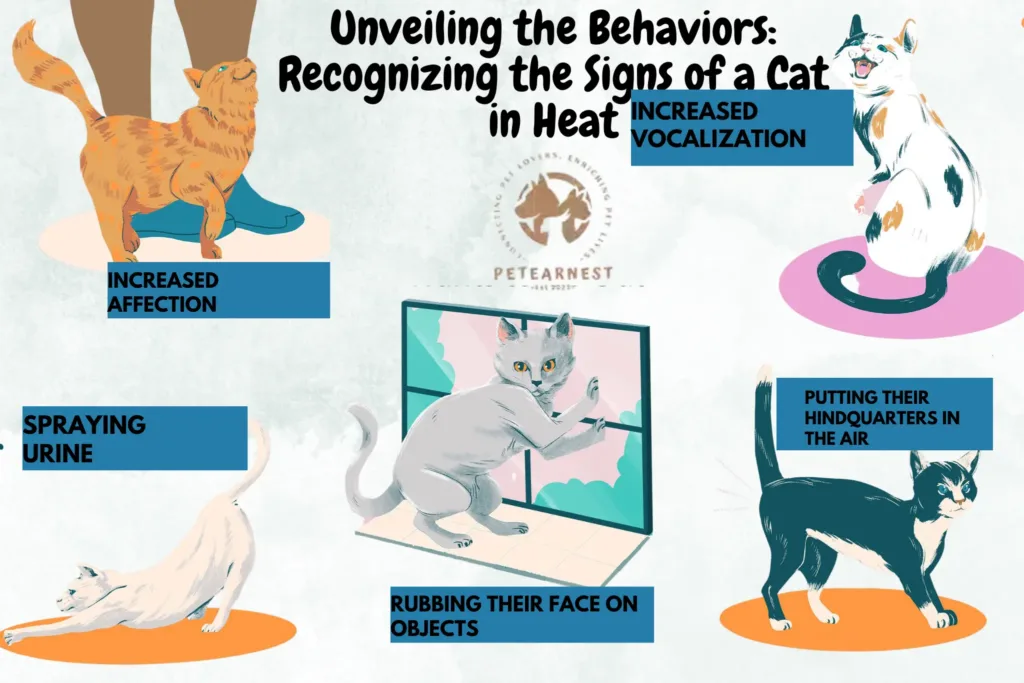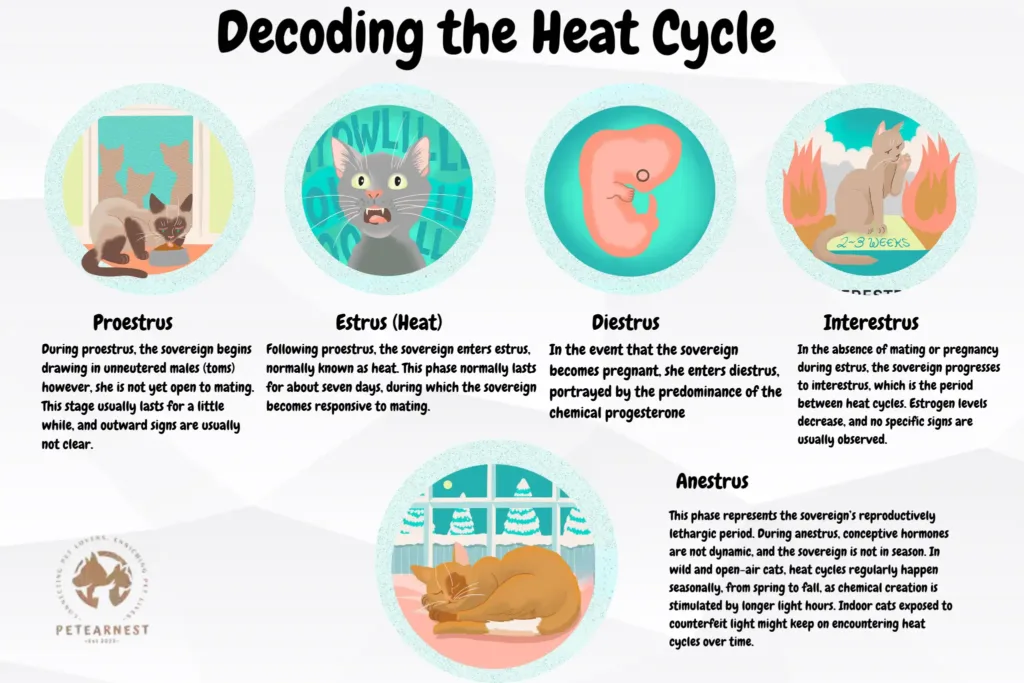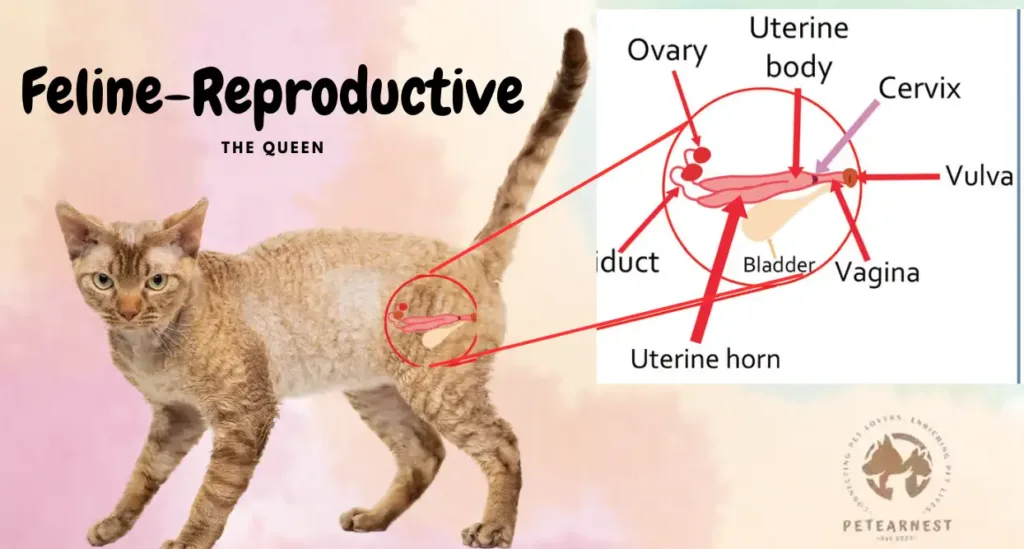How long are cats in heat? It’s a question that often perplexes cat owners, especially when faced with a female cat entering this curious phase. While the recommendation to spay your cat is common, certain circumstances may delay the procedure, leaving you wondering about the duration of your cat’s heat cycle.
On average, experts suggest that cats remain in heat for around seven days. However, the duration can vary significantly, ranging from three to twenty days, typically occurring between the months of February and October. It’s important to note that cats can experience multiple heat cycles within a year, leading to some rather unusual behaviors that might catch you off guard.
During this period, you may observe your feline companion exhibiting heightened attention-seeking behaviors, accompanied by frequent vocalizations resembling howling. As a responsible cat owner, understanding and preparing for your cat’s heat cycle becomes crucial to provide the necessary care and support during this unique time.
In this article, we will delve into the fascinating world of cats in heat, unlocking the mystery surrounding their duration. By gaining insights into this natural phenomenon, you’ll be better equipped to navigate your cat’s heat cycles and ensure her well-being. So, let’s embark on this informative journey and unravel the secrets of how long cats are in heat.
Table of Contents
When does a female cat have her first estrus cycle?
With regards to a female cat’s conceptive cycle, her first estrus, or heat cycle, normally occurs when she reaches pubescence. Overall, cats arrive at sexual development around the age of six months, albeit this time period might change slightly relying upon factors such as the season and the length of sunshine hours.
The estrous cycle, generally known as the heat cycle, is composed of several stages. Nonetheless, it is during the stage known as estrus that a female cat becomes sexually open or “in heat.” This is the period when she is prepared for mating and may display behaviors signaling her accessibility to expected male partners.
Understanding when a female cat experiences her first estrus cycle is essential for cat owners to be ready for the onset of heat and the potential conduct changes associated with it. By opening the mystery surrounding a cat’s regenerative cycle, we can acquire significant insights into the fascinating length of their heat cycles and give the consideration and consideration necessary during this special time.
How often does a female cat come into heat?
The frequency at which a female cat enters into heat depends on various factors, one of which is their seasonal polyestrous nature. Cats experience multiple reproductive cycles during the breeding season. The specific timing of the breeding season can vary based on geographical location and environmental conditions like temperature and daylight hours.
In the Northern Hemisphere, cats typically go through heat cycles from January until the late fall. This pattern aligns with the seasonal changes in daylight hours and temperature. On the other hand, cats residing in tropical regions or primarily indoors may have year-round heat cycles due to the consistent and increased number of daylight hours they experience.
Understanding how often a female cat comes into heat is crucial for cat owners to anticipate and manage their behavior and reproductive needs effectively. By unraveling the mystery behind the frequency of heat cycles, we can gain valuable insights into the fascinating duration and patterns of cats in heat, empowering us to provide the best care for our feline companions.
How Long Are Cats in Heat?
The term of a cat’s heat cycle can fluctuate, yet by and large, it lasts for around seven days. In any case, it’s critical to take note of that the length can go from as short as one day to as long as 21 days. In the event that a female cat is not mated during her heat cycle, she will leave heat for a short period, ordinarily close to seven days. This intermission between heat cycles can differ from 2 to 19 days.
Hence, the total estrous cycle of a cat, including both the heat and non-heat periods, can go somewhere in the range of one to six weeks, with a typical cycle length of roughly three weeks. Understanding the term of a cat’s heat cycle is pivotal for cat owners, as it helps them expect and deal with the conduct and physiological changes that happen during this time.
Unveiling the Behaviors: Recognizing the Signs of a Cat in Heat
Recognizing when a cat is in heat can sometimes be challenging, but once you know the signs, it becomes much easier to identify. Being able to recognize these signs is not only useful for understanding your cat’s reproductive state but also for scheduling spay appointments or anticipating future heat cycles.
- Increased vocalization: One prominent behaviour of cats in heat is increased vocalization. While you may be accustomed to occasional meowing from your cat, when she is in heat, her vocalization escalates. Cats in heat will yowl, cry, and meow frequently and loudly, as they are trying to attract male cats.
- Increased affection: Another noticeable sign is increased affection towards their human companions. Cats in heat tend to seek more attention and become extra affectionate. They enjoy being petted, stroked, and scratched, particularly along their back and rear. So, if your cat exhibits heightened snuggliness and seeks more affection than usual, it could indicate that she is in heat.
- Spraying urine and menstruation: During this time, you may also observe your cat spraying urine, which is a clear indication of her readiness to mate. Additionally, it is normal for female cats to have a slight amount of bleeding during their heat cycle. However, if there is excessive bleeding, it might signal a urinary tract infection or another underlying issue, requiring veterinary attention.
- Rubbing their face on you or other items around the house: Cats in heat often engage in face-rubbing behaviour to spread their scent. By rubbing their face on objects like your jeans, couch, or floor, they are marking territory and attempting to attract potential mates.
- Putting their hindquarters in the air: Another peculiar behaviour is when a cat raises her hindquarters in the air and wiggles them slightly. This action serves as a visual signal that she is seeking a mate.
By recognizing these distinct signs, cat owners can gain insights into their feline companion’s heat cycle and be better prepared for the duration and accompanying behaviours. Understanding and decoding the mystery of how long cats are in heat allows for optimal care and management during this unique phase.

Decoding the Heat Cycle: Understanding the Stages of a Cat’s Reproductive Journey
Understanding the regenerative pattern of cats is fundamental for feline proprietors who need to be learned about their pets fruitfulness and the phases of heat cycles the term in heat alludes to the period when a feline is physically open and fit for becoming pregnant this stage is known as estrus happens once the feline arrives at sexual development which normally occurs close to four months old enough the particular timing of sexual development might differ in light of elements, for example, hereditary qualities and breed its important that female cats don’t encounter torment during their heat cycle in spite of the fact that they might feel some uneasiness.
We should investigate the various stages of a cat’s heat cycle:
- Proestrus: During proestrus, the sovereign begins drawing in unneutered males (toms) however, she is not yet open to mating. This stage usually lasts for a little while, and outward signs are usually not clear.
- Estrus (Heat): Following proestrus, the sovereign enters estrus, normally known as heat. This phase normally lasts for about seven days, during which the sovereign becomes responsive to mating. She might show behaviours such as expressing boisterously, moving around, scouring on objects, and lifting her backside. A decreased craving is also normal during this stage. Mating during estrus induces ovulation, as the demonstration of mating triggers chemical creation that leads to ovulation. To increase the chances of pregnancy, the sovereign regularly needs to mate on different occasions, usually around four to six.
- Diestrus: In the event that the sovereign becomes pregnant, she enters diestrus, portrayed by the predominance of the chemical progesterone. Prepared eggs (oocytes) form into embryos and become embedded in the uterus around 12 to 13 days in the wake of mating. Nonetheless, not all embryos successfully survive this process, with around 84% successfully embedding in the uterus.
- Interestrus: In the absence of mating or pregnancy during estrus, the sovereign progresses to interestrus, which is the period between heat cycles. Estrogen levels decrease, and no specific signs are usually observed. After around two days to three weeks, the sovereign will enter heat in the future, proceeding with the pattern of proestrus, estrus, and interestrus all through the mating season or until pregnancy occurs.
- Anestrus: This phase represents the sovereign’s reproductively lethargic period. During anestrus, conceptive hormones are not dynamic, and the sovereign is not in season. In wild and open-air cats, heat cycles regularly happen seasonally, from spring to fall, as chemical creation is stimulated by longer light hours. Indoor cats exposed to counterfeit light might keep on encountering heat cycles over time.
By getting to know the stages of a cat’s heat cycle, cat owners can acquire a more profound understanding of their pet’s conceptive way of behaving and go with informed choices in regards to spaying, rearing, or dealing with their cat’s regenerative well-being.

Preventing Heat: How to Keep Your Cat From Going Into Heat
Managing a cat in heat can pose challenges for cat owners, and the possibility of an unintended pregnancy only adds to the concerns. So, the question arises: Is there a way to prevent your cat from going into heat? The most effective method is to have her spayed.
“Healthy kittens can undergo spaying as early as six to eight weeks old in certain cases, while it is generally recommended that all cats be spayed by the age of five months.” Ideally, female cats should be spayed before their first heat cycle, which can start as early as four months.
A spay procedure involves the removal of the ovaries and uterus, known as an ovariohysterectomy. Although it may sound like a major surgery, most cats and kittens can return home on the same day of the spay.
If your cat is already in heat, it is still safe to proceed with the spay. Additionally, spaying cats and kittens promote their long-term health. Studies have shown that spaying reduces the risk of mammary cancer by 91% and eliminates the possibility of developing a life-threatening uterine infection called pyometra. In fact, if your cat is currently experiencing a particularly intense and noticeable heat cycle, spaying will bring it to a halt.
By opting for spaying, you not only prevent your cat from going into heat but also contribute to her overall well-being and reduce the risks associated with reproductive health issues.

Improving Lives: The Advantages of Spaying and Neutering Cats
Spaying female cats is a well-known practice to prevent unwanted pregnancies and address reproductive health concerns. However, it is equally important to highlight the benefits of neutering male cats. According to Dr. Gary Richter, DVM, an esteemed veterinarian on The Dog People Panel, neutering male cats offers a range of advantages that contribute to their overall well-being.
First and foremost, neutering eliminates the chances of unplanned reproduction, ensuring that your male cat won’t father litters of kittens. Additionally, it eliminates the risk of testicular cancer, a potential health issue for intact male cats. By reducing the production of testosterone, neutering also decreases the likelihood of pet-to-pet aggression, making your cat more sociable and compatible with other animals in your household.
Neutering further minimizes the tendency of male cats to engage in urine spraying, a behavior often associated with marking territory. This helps maintain a cleaner and more pleasant environment within your home. Moreover, neutering reduces a cat’s inclination to roam or engage in door-dashing activities in search of a mate, keeping them safe from potential dangers outdoors.
Dr. Richter emphasizes that neutering male cats not only addresses behavioral issues but also improves their overall quality of life. While weight gain and urinary tract disease may be potential concerns for neutered cats, discussing healthy lifestyle choices with your veterinarian can help mitigate these risks and ensure your cat leads a happy and healthy life.
By spaying and neutering cats, we can proactively address reproductive concerns, promote responsible pet ownership, and enhance the well-being of our feline companions.
Take Away: Spaying Prevents Heat and Enhances Cat’s Well-being
“Spaying and neutering your cats not only prevent unplanned pregnancies but also promote their long-term health and well-being, reducing the risk of serious diseases and behavioral issues. Take the proactive step towards responsible pet ownership and ensure a happier, healthier life for your beloved feline companions.”
Dr. Chandrika
Tweet
Understanding the intricacies of a cat’s heat cycle and the associated behaviors can be essential for cat owners. Female cats experience heat cycles, known as estrus, during which they are open to mating and can become pregnant. These cycles normally happen when the cat reaches sexual development, about four months old enough.
Perceiving the signs of a cat in heat, such as increased vocalization, loving way of behaving, spraying pee, and scouring their face on objects, can assist owners with recognizing when their cat is in this regenerative phase. The length of a cat’s heat cycle can change, yet by and large, it lasts for about seven days.
To forestall the challenges and potential complications associated with heat cycles, neutering female cats is energetically suggested. Spaying involves the evacuation of the ovaries and uterus, killing the capacity to imitate. Spaying prevents impromptu pregnancies as well as offers numerous medical advantages for female cats. It significantly reduces the risk of mammary malignant growth and eliminates the possibility of uterine infections like pyometra.
Similarly, it means a lot to fix male cats. Fixing eliminates the chances of spontaneous generation, reduces the risk of testicular malignant growth, minimizes pet-to-pet aggression, and decreases the probability of pee spraying. Neutered male cats also display a decreased propensity to meander or participate in entryway dashing behaviors in search of a mate.
By spaying and fixing cats, owners can proactively address regenerative concerns, advance responsible pet ownership, and further develop the general prosperity of their catlike companions. Consulting with a veterinarian is pivotal to understand the ideal timing for spaying or fixing and to ensure the drawn out wellbeing and happiness of our darling cats.
References:
- Brooks, W. “Feline Spay FAQ”. Animal Care Center. (2020). http://www.accvets.net/wellness/pet-spay-neuter/feline-spay-faq/.
- Bukowski, J. Aiello, S. “Breeding and Reproduction of Cats”. Merck Veterinary Manual. (July 2011). https://www.merckvetmanual.com/cat-owners/routine-care-and-breeding-of-cats/breeding-and-reproduction-of-cats?.
- Finn, E. “Pyometra: What is it and Why Does it Happen?”. MSPCA-Angell. (2022). https://www.mspca.org/angell_services/pyometra-what-is-it-and-why-does-it-happen/.
- Griffin, B. “Prolific Cats: The Estrous Cycle”. Scott-Richey Research Center. (December 2001). http://assets.prod.vetlearn.com.s3.amazonaws.com/mmah/c8/4524e5b2f84140bc3aa42fdf307687/filePV_23_12_1049.pdf.
- Johnson, R. “Timely Sterilization Makes Sense for the Practice and the Pets”. Nichols Hills Veterinary Clinic. (Accessed July 12, 2022). https://mariansdream.org/animal_welfare/wp-content/uploads/Johnson_Timely_Sterlization1.pdf.
- “Pets by the Number”. The Humane Society of the United States. (2022). https://humanepro.org/page/pets-by-the-numbers.
-
Little, Susan E. Female Reproduction. The Cat, 2012, pp. 1195-1227. Elsevier, doi:10.1016/b978-1-4377-0660-4.00040-5
-
Spaying And Neutering. Cornell University College Of Veterinary Medicine, 2020


